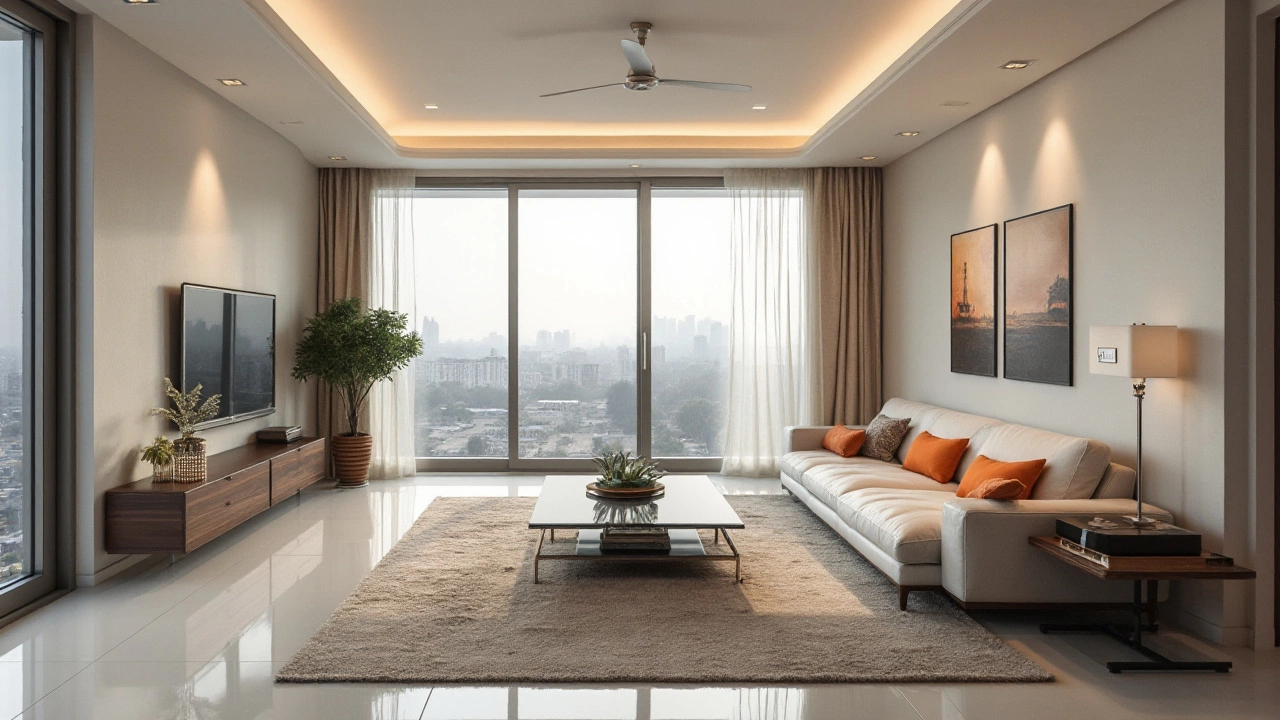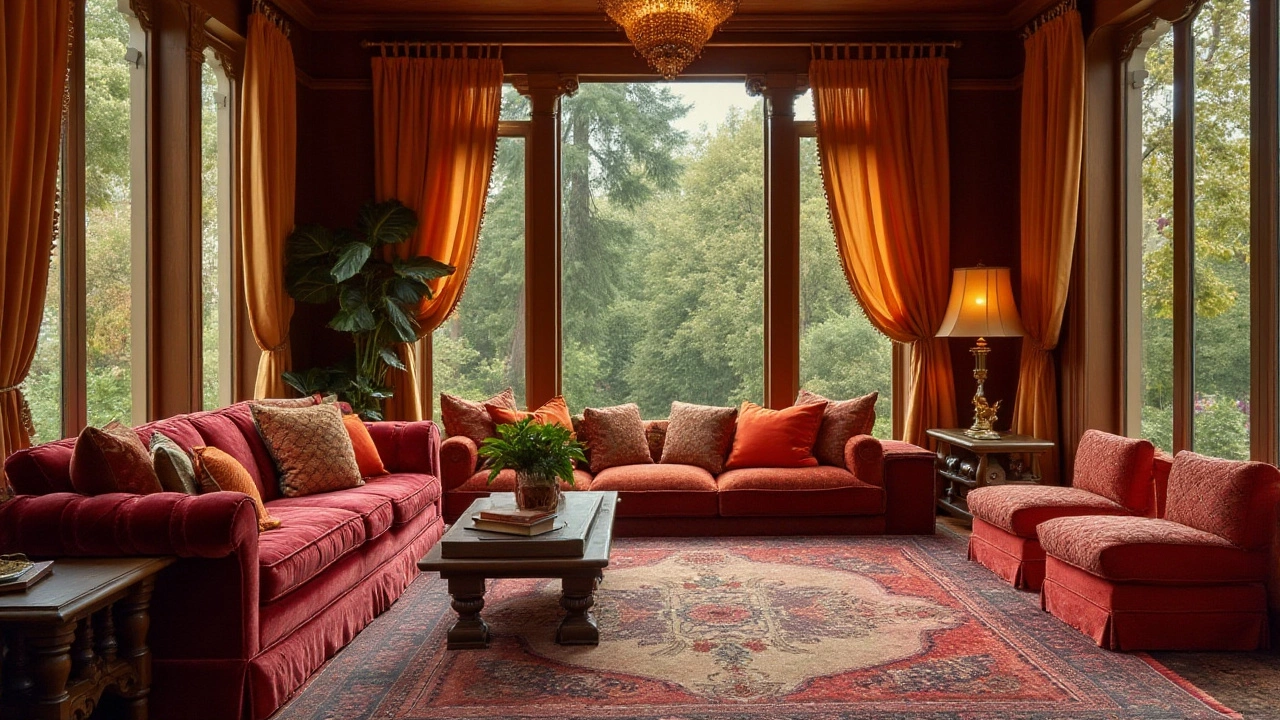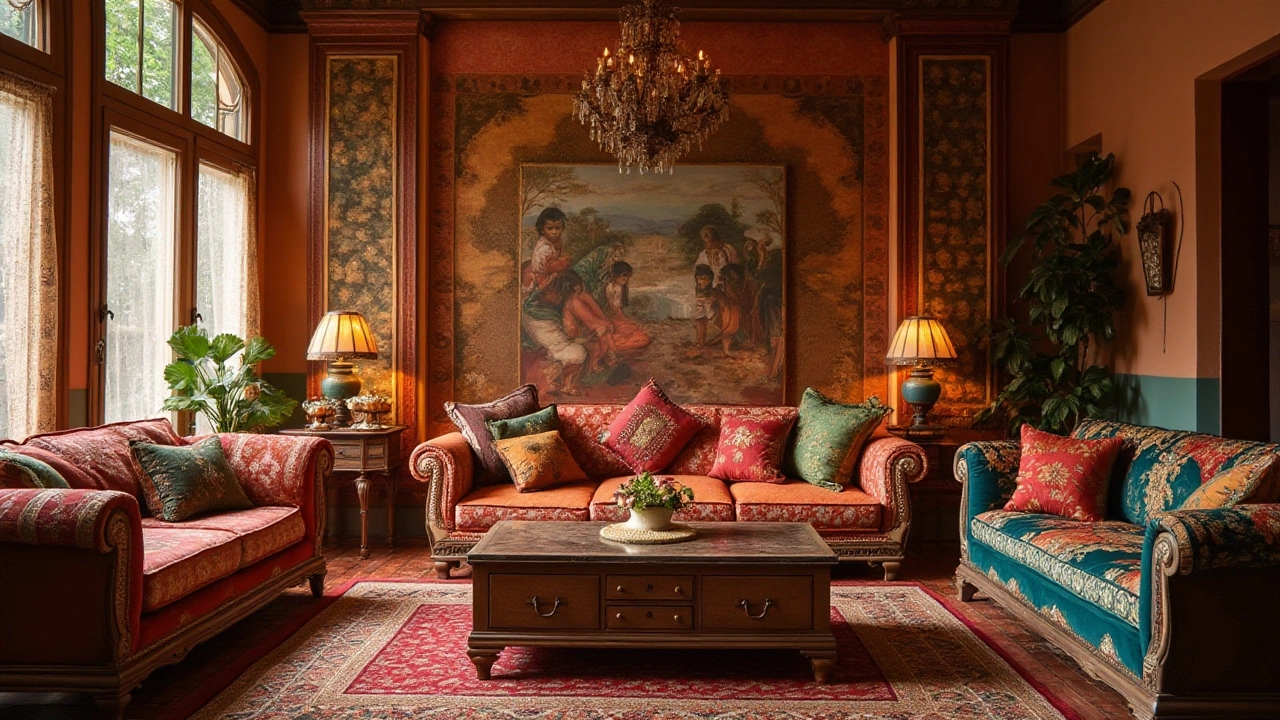Finding the perfect sofa can feel like a daunting task. It’s where you gather with friends, unwind after a busy day, and maybe even sneak in a nap or two. The right choice blends comfort, style, and practicality, turning any space into your personal retreat.
From the texture of the fabric to the size that fits just right, and the style that calls your name, there's a lot to ponder. Let’s navigate through these options, exploring what makes each type unique, and discover the secrets to choosing a sofa that fits just as well in your home as it does in your life.
- Understanding Sofa Materials
- Sofa Styles to Fit Any Home
- Choosing the Right Size
- Functionality and Usage
- Maintenance and Care Tips
- Making the Final Decision
Understanding Sofa Materials
When it comes to selecting a sofa, one of the pivotal aspects to consider is the material. It not only influences the aesthetic appeal of your living area but also dictates the durability and comfort sofa sets offer. Fabric choices range widely, and knowing their unique characteristics can significantly impact your decision. Leather, a classic choice, provides an elegant and timeless look. It’s lauded for its toughness and ease of cleaning, making it ideal for families with children or pets. However, it could feel somewhat cold during winter months or sticky in the summer heat. Fabric options, on the other hand, like cotton or linen, are soft and inviting. These materials bring a cozy and welcoming feel, though they might require more maintenance to fend off stains and wear. If you're aiming for a combination of both resilience and softness, microfiber is a popular choice that emulates suede's plush texture while being manageable.
When delving deeper into the material world, attention should also be given to eco-friendly alternatives. As more people become environmentally conscious, finding living space furniture that aligns with these values has become paramount. Sustainable fabrics such as organic cotton and bamboo are not only gentle on the planet but also deliver a quality seating experience. They offer comfort with a clear conscience, without compromising on style. Velvets and chenilles add an element of luxury and glamour; however, they require careful upkeep to maintain their sheen and plushness. Considering your household's lifestyle, including potential spills and frequent usage, informs which fabric might best suit your needs. As a timeless piece of advice from The Upholstery Association states, "Choose a material that harmonizes with your lifestyle as much as your design tastes."
Another critical factor tied to sofa materials is color and pattern choice. Neutral tones like grays, beiges, and creams adapt gracefully to various decor styles, making them a safe bet for many home decor visions. They also allow for more flexibility when it comes to accessorizing with pillows, throws, and other furniture pieces, giving you the freedom to change aesthetic themes over time. Patterned fabrics can inject personality and dynamism into a space, although it requires a more cautious approach. What complements today’s trends might overshadow tomorrow’s preferences, so balance and foresight are essential. As more attention turns to style and function, understanding the interplay between a sofa’s fabric and how it fits into your living environment helps in making an informed decision, ensuring comfort and style go hand-in-hand.
Sofa Styles to Fit Any Home
The world of sofas is vast and fascinating, much like wandering through a gallery of art; each piece tells a story. Whether you lean towards the clean lines of a modernist piece or the comforting arms of a traditional sofa, there’s something out there that perfectly aligns with your taste.
Modern and Contemporary
Modern and contemporary styles often feature sleek designs, favoring minimalism and functionality. These sofa sets are ideal for those looking to create a sophisticated ambiance, with materials such as leather often taking center stage. The absence of excessive ornamentation allows the materials and design to shine, making these types perfect for smaller spaces due to their typically lighter and airier feel. If you’re someone who loves a clutter-free home, a contemporary sofa is a fitting choice.
Traditional and Classic
The classic styles draw inspiration from times past, embodying elegance through rich materials and intricate details. Think of the plush comfort of English roll arm sofas or the stately appeal of a Chesterfield. Chesterfields, for instance, date back to the 18th century with their deep button tufting and scrolled arms. They add a level of sophistication to any room and are perfect for creating a cozy nook to enjoy with guests or family. These traditional designs often offer deeper seats and more plush cushioning, which makes them ideal for long movie nights or a warm reading afternoon.
Bohemian and Eclectic
For those who enjoy a bit of whimsy and creativity, eclectic sofas allow your personality to shine through. Mixing textures, colors, and patterns, this style breaks away from the uniformity and encourages a more personal touch. Don’t shy away from a color palette that’s bold or unexpected; let it be a reflection of your diverse tastes. These sofas are generally adaptable, allowing one to experiment with the aesthetics of their living space furniture without committing to a single style or material.
"Home is where the heart is," they say, and what better way to reflect that sentiment than with a piece that feels uniquely yours? — Home and Style Magazine
Multi-Functional Designs
Living in an era where space is often at a premium, multi-functional sofas are becoming increasingly popular. Think of the trusty sofa bed or a sectional sofa that can shift to fit the needs of the moment. These are designed for practicality without sacrificing style, often incorporating hidden storage or the ability to transform with ease. They are especially handy in smaller apartments where maximizing space efficiency is not just preferred but essential. Home decor isn’t just about aesthetics; it’s also about effectively using every inch of your space, and these adaptable sofas fit the bill perfectly.
Each style offers something unique, catering to different needs and preferences. The key is to identify what resonates with you, not just in terms of design, but also in the context of your everyday life. As we continue to evolve in our tastes and requirements, the world of sofas evolves too, providing a wealth of options that promise comfort, style, and utility.

Choosing the Right Size
When it comes to selecting the perfect sofa sets for your living space, size is an element that demands careful consideration. A sofa that's too small might not provide enough seating for your guests, while one that's too large can dominate the room and hinder movement. To strike the perfect balance, start by measuring the dimensions of your room. Take into account doorways, windows, and any architectural quirks. Your goal is a sofa that complements the space without overwhelming it. Standard sofa lengths range between 72 and 96 inches, which fits comfortably in most living rooms, but if you’re tight on space or seeking a cozy nook, compact models are your friends. Loveseats or two-seaters, typically 60 inches or less, provide snug seating for limited areas.
The seating arrangement plays a pivotal role in determining what size will work best. If you enjoy hosting, consider modular or sectional sofas, which offer flexibility to rearrange and adapt for larger gatherings. On the other hand, for more intimate settings or primary use by one or two people, a traditional three-seat might suffice. Pay attention to the depth as well; deeper sofas are ideal for lounging and casual comfort while those with a shallower depth provide a more formal feel, often promoting good posture.
"A common mistake is forgetting to consider the scale of furniture," advises interior design expert Sheila Bridges. "Big couches don’t necessarily mean better couches. Matching the proportion is crucial for maintaining a sense of harmony in the room."
Additionally, be mindful of height, both for backrests and seat cushions. Taller backrests offer neck and shoulder support, which is a must for taller family members. Meanwhile, the height of the seat affects ease of sitting and standing, and may be adjusted for different needs or preferences. A comfortable seat height usually falls between 15 and 20 inches from the floor. Lastly, simulate your intended layout with masking tape to visualize how the sofa will fit with other furnishings. Use this to ensure there's ample space for pathways, as a good flow is as important as comfort.
Functionality and Usage
When considering the functionality and usage of a sofa set, it’s essential to weigh how it integrates into your daily life. A living room sofa often serves as more than a seating arrangement; it's a gathering spot for family movie nights, a crash pad for unexpected guests, and possibly even a workspace for those who prefer a cozy environment over a desk. Therefore, it should meet your lifestyle demands while also fitting seamlessly into the aesthetic of your home.
One critical aspect to examine is the versatility of the sofa. Multi-purpose designs, like sectional sofas, allow you to rearrange pieces to suit varying activities or occasions. These sofas offer flexibility, accommodating different seating configurations, which is ideal for smaller spaces or urban apartments. Sleepers and futons provide an excellent solution for homes without a designated guest room, transforming a living area into an impromptu bedroom with minimum hassle. For those who often host, these options can significantly enhance usability, making guests feel right at home.
The materials used in a sofa can also influence its functionality. Leather sofas, although sometimes considered a luxury, are known for their durability and ease of maintenance. They can withstand heavy use, making them a favorite among families with young children. On the other hand, fabric sofas might offer more variety in textures and colors, allowing a personalized touch but might require more attention when it comes to cleaning and upkeep. The fabric's resistance to stains and fading is something to consider, especially if the sofa is exposed to direct sunlight.
Functionality goes hand-in-hand with the technological integration some modern sofas offer. From built-in USB ports for convenient device charging to adjustable reclining features controlled via Bluetooth, the modern sofa can be as advanced as any tech gadget. A study published by the Institute of Furniture Technology in 2023 highlighted that about 20% of new furniture purchases in urban areas included some form of technologically enhanced products, suggesting a trend towards smart furniture that caters to tech-savvy homeowners.
Moreover, how your sofa is used will also depend on the household dynamic. For larger families, or homes frequently hosting guests, investing in a durable and expansive living space furniture option is wise. If you share the space with pets, fabrics that resist hair and claws are worth exploring. More intimate, smaller households might prioritize aesthetics over durability, opting for trendier designs that make a statement.
Lastly, cost versus usage ratio should be evaluated. While an elegant velvet couch might be appealing, if replaced every year due to wear, it can be a financial strain rather than a style investment. The key is to find that sweet spot between style, comfort, and practicality which suits both your lifestyle and your budget.
"A sofa should not follow design principles, but your personal need for comfort and functionality," renowned interior designer Susan Cairns has noted, emphasizing the importance of personal fit over fashionable trends.

Maintenance and Care Tips
To truly enjoy the longevity and allure of your beloved sofa sets, dedicating some time to proper maintenance and care is crucial. The efforts are not just about preserving the looks but also about ensuring comfort over the years. Maintaining a sofa isn't entirely a daunting task; it involves a blend of routine cleaning, immediate attention to spills, and strategic placement within your living space. Begin by understanding the material you're working with, as the type of fabric or leather dictates specific care requirements. For instance, while vacuuming helps keep fabric sofas free from dust and debris, leather sofas benefit more from regular conditioning to maintain their luxurious sheen and prevent cracks.
Aside from routine cleaning, dealing with spills promptly is vital. Everyone dreads the accidental coffee spill or those little handprints from the tiny tots. Acting fast can significantly reduce stain penetration. For fabric sofas, blot the stain with a clean, damp cloth without rubbing, which can embed the stain deeper into the fibers. In contrast, for leather sofas, wiping with a dry or slightly damp cloth and using a leather cleaner can work wonders. According to interior designer Alex Jenkins, "The secret to a well-maintained sofa lies not just in cleaning, but in preventing future damage. You'd want to think about everything from scratch-proof covers to strategically placing your sofa away from direct sunlight, which can cause fading."
"Preventative measures are crucial in sofa care – they not just protect but enhance the lifespan," Alex added.
Your home’s environment also plays a considerable part in your sofa’s upkeep. Living room arrangements should favor placements that avoid constant direct sunlight, which could contribute to material fading. If moving your sofa is not an option, using UV-protection window films or adding drapes to filter sunlight can help tremendously. Further, consider the temperature and humidity. Both extreme dryness and humidity can influence furniture longevity. Using humidifiers during the dry months or dehumidifiers in high-humidity conditions can maintain an optimal environment for your furniture.
Regular maintenance doesn't stop at cleaning; it extends to the structural integrity of your sofa sets. Every few months, it's a good idea to flip the cushions and rotate them to ensure even wear, much like you would with a mattress. Older sofas can benefit from checking and tightening bolts or screws to maintain sturdiness. If you own a piece with detachable parts, such as a sectional, reconfiguring the pieces occasionally can distribute wear evenly and present a fresh look in your living room. Such diligent care combined, can add years to your sofa and maintain its appearance and comfort.
Ultimately, creating a preventive care routine tailored to your particular sofa can significantly enhance its life span and preserve its aesthetic. Enlisting the help of professional cleaning services for an annual deep clean can be a worthwhile investment, especially for high-end pieces or those crafted from delicate fabrics. Many modern cleaning services offer eco-friendly options, which could align with your preferences for a sustainable lifestyle. Use these professional cleans to complement your regular quick tidy-ups, ensuring your best sofa type remains in prime condition for as long as possible.
Making the Final Decision
When you're on the brink of choosing the perfect sofa set, remember that the decision should be as much about emotion as it is about logic. Visualize yourself and the life you lead—is the sofa a canvas for family memories, the spot where you curl up with a book, or a backdrop for chic gatherings? Each purpose calls for a different feature, a different feel. Sofa is more than just a piece of furniture; it establishes the ambiance of your living space. Comfort, sustainability, and aesthetics should balance out like a well-composed symphony.
Trust your instinct but also weigh in on practical aspects. Financial constraints should certainly shape the boundaries of your decision, but never let them cloud the joy of finding a sofa that feels like home. It may sound whimsical to say, yet many people have found their perfect piece by simply ‘clicking’ with it — an unspoken harmony that aligns with your style and spirit.
In terms of technical details, focus on the construction of the sofa. A kiln-dried hardwood frame ensures longevity over softer woods. Many experts emphasize the importance of stable and sound joinery, like dowels or corner blocks. Look into the cushions too, as high-density foam wrapped in a layer of polyester provides both support and softness that lasts. A fabric or leather that speaks to you is essential, but seeing how it performs in your lifestyle completes the picture.
When speaking of comfort, take into account the fill of your sofa cushions. A blend of feathers and foam gives a more luxurious and plush seat, but pure foam may offer better shape retention over time. A quote from the renowned interior designer Nate Berkus encapsulates this decision process:
"Your home should tell the story of who you are, and be a collection of what you love."His philosophy suggests that every piece, including your best sofa type, should resonate with personal meaning and functionality.
Finally, give thought to how this new piece will meld with the other elements in your home. Take into consideration the colors, existing decor, and room size. Creating a mood board or digital collage can help visualize this integration. Should you lean towards contemporary trends or prefer a timeless, classical look, make sure your choice sings in harmony with your overall style goals, while leaving room for future transformations and additions.
By meshing mindful consideration of technical aspects with your innate attraction to a particular design, you’ll find the sofa that fits seamlessly into your living space, enriching it for years to come. Your living area will become more than just a room; it transforms into a cherished sanctuary where each cushion and curve reflects your unique style.

